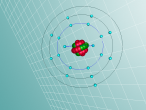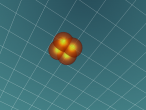Grace Clemens
Atoms, being the smallest basic unit of a chemical element, provide the structures for all chemical elements and therefore, entirely make up the world around us. Atoms themselves consist of three types of sub-atomic particles being neutrons, protons and electrons all of which have different electrical charges that affect their behaviour and physical characteristics. For instance, the atom Potassium (K) usually has 19 protons (positively charged), 19 electrons (negatively charged) and 20 neutrons (neutral/no charge) and when in its purest form, appears as a very soft metal. In this blog entry, a 3D planetary model (with neutrons) representation of a potassium atom is included as well as a description of some of its predominant properties and uses.
Potassium is an element with four shells of electrons (2,8,8,1) that orbit the nucleus which most often contains 19 protons and 20 neutrons. Its melting and boiling points are 336.7K and 1032K respectively and it has an atomic mass of 39.0983amu. Potassium salts have been known and used for centuries and the element was left wrongfully classified by Antoine Lavoisier however, it wasn't until 1807, when Sir Humphry Davy exposed potassium carbonate to an electric current and small, metal bubbles formed that it was officially classifies as a new metal. The melting point of potassium is 336.7K and it boils at 1032K. It can be obtained through various minerals including sylvite, carnallite and polyhalite. While pure potassium cannot be found in minerals or more broadly, nature generally, the element is the eighth most abundant on Earth and accounts for about 2.1% of the earths crust.
The most common form of potassium has four shells however, the fourth only contains one electron. This makes potassium an extremely reactive element that can even burn when introduced to water or oxygen. Its reactivity is also the reason it cannot be found naturally in its element state, as a soft, silvery-white and lustrous metal, making it only common in minerals and plant cells. Potassium also has a very explosive reaction when it comes into contact with dilute acids.
As previously stated, the use of potassium salts extends relatively far back into history, being used in gunpowder, dyeing agents and the making of soaps. Furthermore, they were scraped from latrine walls then manufactured from clay and sulphuric acid to be collected as wood ash. Its usefulness as an element however, has moved from its great importance of being turned to ash from toilet scrapings and now is commercially used as a compound in fertiliser and other demands for potassium compounds include the manufacturing of glass,detergent and pharmaceuticals. Its significance also lies in its biological role as potassium ions are found in all cells and are important for maintaining a balance of fluids and electrolytes. Plant cells in particular are reliant on and rich in potassium obtained from the soil however, a healthy human diet is also dependent on an estimated 7 grams of potassium per day making it a significant and vital element due to its biological and material properties.
Potassium is a complex and highly useful element in the periodic table. For one I still have questions about its formation (how, when it was originally formed) as well as questions regarding how potassium reacts so harshly with the most common elements on Earth but is still the eighth most common element in its crust. For further information, a list of sources is below:
http://www.rsc.org/periodic-table/element/19/potassium
http://education.jlab.org/itselemental/ele019.html
http://www.livescience.com/29025-facts-about-potassium.html
http://scitation.aip.org/content/aip/journal/jcp/74/2/10.1063/1.441152
Prior to the VRMath Workshop at QUT I had little to no experience with proper coding in a 3D space. While definitely challenging and tedious, it was satisfying to run a code I'd written and see the actions it affected (when successful). I had some trouble with getting certain transforms to move and not being able to quite control the rate they spun at (hence why three of the electron shells on the 3D model move at the same rate). Besides the animation, I found most of the programming relatively simple and easy to catch on to and, through a long process of trial and error, was able to make most of the model run smoothly
Link to program:
https://vrmath2.net/VRM2/
























